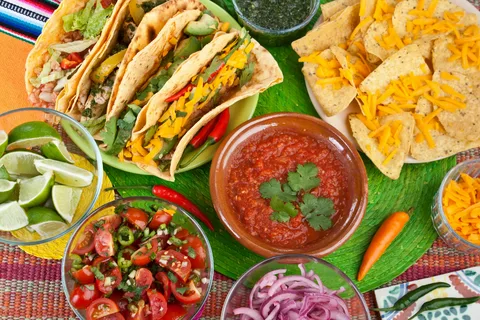Table of Contents
The Heart of Texas Mexican Cuisine: A Cultural Melting Pot
Tracing the Roots: How History Shaped Texas Mexican Food
The unique tapestry of Texas Mexican cuisine is woven from centuries of history, migration, and cultural exchange. The origins of this culinary tradition date back to the 19th century when a confluence of cultures began to form in the Southwest region of the United States. With Mexican settlers introducing traditional recipes, and the influx of Anglo settlers bringing their culinary practices, a rich and diverse food culture emerged. Over time, Texas was influenced by the Spanish colonial period, where indigenous ingredients like corn and beans were combined with Spanish flavors. This blending of flavors is not merely a culinary phenomenon; it is a historical narrative that reflects the diverse experiences of the people who have called Texas home. Regions like San Antonio became pivotal centers for this culinary evolution, where vibrant pueblitos served as hubs for both agricultural growth and gastronomic innovation.
Influences from Mexico: The Ingredients That Tell a Story
At the core of Texas Mexican food is a collection of staple ingredients that pay homage to both its Mexican roots and local agriculture. Essential elements such as corn, beans, and chiles are fundamental to the cuisine, each representing cultural significance. Corn, for instance, is not only a dietary staple but also holds spiritual connotations, rooted deeply in the traditions of indigenous people. Chiles, ranging from the fiery jalapeño to the smoky chipotle, infuse dishes with distinct regional flavors. Moreover, ingredients like queso fresco, lime, and cilantro reflect a seamless blend of Mexican heritage with local tastes, creating dishes that resonate with Texans. The overarching respect for fresh produce is evident in every bowl and plate, illustrating how Texas Mexican cuisine is not a static entity but a continually evolving food experience influenced by the landscape and community.
Savoring Iconic Dishes: Beyond Tacos and Enchiladas
Barbacoa and Birria: The Comfort Foods of Texas
While tacos and enchiladas often steal the spotlight in discussions about Texas Mexican cuisine, it is the traditional dishes like barbacoa and birria that often resonate more closely with comfort food. Barbacoa, traditionally made from the head of a cow, is slow-cooked until tender, often infused with complex spices and served with flavorful broth. Its preparation showcases a deeply rooted tradition that emphasizes communal eating and family gatherings. Meanwhile, birria, a savory stew made primarily with goat or beef, exemplifies the bold flavors characteristic of this cuisine. The dish excels in utilizing rich spices like cumin, oregano, and clove which not only elevate the taste but also reflect the regional cooking practices. Both barbacoa and birria serve as testaments to the labor of love that characterizes true Texas Mexican food, where recipes are often passed down through generations, becoming synonymous with family heritage and identity.
Tex-Mex vs. Traditional: Understanding the Flavor Profiles
The terms “Tex-Mex” and “traditional Mexican cuisine” are often used interchangeably in casual conversation, yet they represent distinct culinary philosophies. Tex-Mex, a fusion borne out of cultural convergence, is characterized by its adoption of American ingredients and cooking styles while maintaining its Mexican roots. It embraces bold flavors, cheesy goodness, and generous portions a reflection of the heartiness cherished by many Texans. Traditional Mexican cuisine, in contrast, tends to emphasize regional ingredients and traditional methods, reflecting the rich tapestry of Mexico’s cultural heritage. Understanding the nuances between these two styles is crucial for anyone delving into Texas Mexican food, as it underscores the diversity and richness of flavors that continue to shape eating experiences across the state.
Exploring Regional Variations: What Makes Each Area Unique?
From San Antonio to El Paso: Distinctive Flavors Across the State
Texas boasts a vast landscape of culinary diversity, particularly when it comes to Texas Mexican food. In San Antonio, for instance, the food scene is infused with a sense of history, reflective of its colonial past. Dishes like puffy tacos, often filled with a variety of proteins, have transformed into a local staple that signifies the city’s unique culinary identity. On the other hand, El Paso food culture brings a different flair characterized by its emphasis on spicy flavors and bold tamales, often made with a variety of fillings wrapped in masa. The interplay of unique cooking methods and key local ingredients gives each region its distinctive flavor profiles, creating a culinary mosaic that is deeply representative of the diverse communities and histories embedded in Texas.
Elevated Street Food: The Art of the Texas Taco Stand
The taco stand phenomenon is a profound aspect of Texas Mexican cuisine, representing not only a culinary style but also a community hub that fosters connection and culture. These stands elevate the humble taco to a celebrated dish featuring a plethora of fillings from traditional carne asada to modern fusion options that marry flavors from around the world. Accessing a tacqueria provides insight into the lively street food culture deeply embedded in Texan life. The use of fresh ingredients, handcrafted tortillas, and time-honored recipes creates a dining experience that reflects the heart and soul of the communities they serve. Such establishments are often family-run, reinforcing a sense of continuity and heritage that keeps traditional practices alive while inviting culinary innovation to flourish.
The Future of Texas Mexican Food: Trends and Innovations
Farm-to-Table: A New Era in Mexican Cuisine
The farm-to-table movement has permeated Texas Mexican cuisine, leading to a renaissance in how dishes are conceptualized and prepared. Chefs are increasingly prioritizing locally sourced ingredients, forging connections with local farmers to ensure freshness and sustainability. This commitment not only promotes healthier eating but enhances the flavors inherent in the ingredients themselves. Local produce officers may find their way into traditional recipes, adding layers of flavor and nourishments that reflect the region’s agricultural landscape. Notable eateries are now combining traditional techniques with innovative presentations, showcasing the versatility of classic dishes while honoring their origins. This approach empowers consumers to choose dining options that align with conscientious culinary practices while supporting local economies.
Fusion Flavors: Where Texas Meets Global Culinary Trends
With the ever-evolving nature of dining experiences, fusion cuisine has emerged as a central theme in the future of Texas Mexican food. Influences from a wide variety of global culinary practices ranging from Asian to Mediterranean are inspiring Texas chefs to experiment with original flavors and hybrid dishes. Picture a Korean barbecue taco or a Mediterranean-inspired enchilada, where traditional ingredients are reimagined through the lens of global culinary trends. These playful interpretations not only captivate the taste buds but also reflect the dynamism of cultural exchange that defines Texas as a melting pot. This fusion approach adds excitement to the dining experience while allowing for creativity and innovation that keeps the culinary landscape vibrant.









